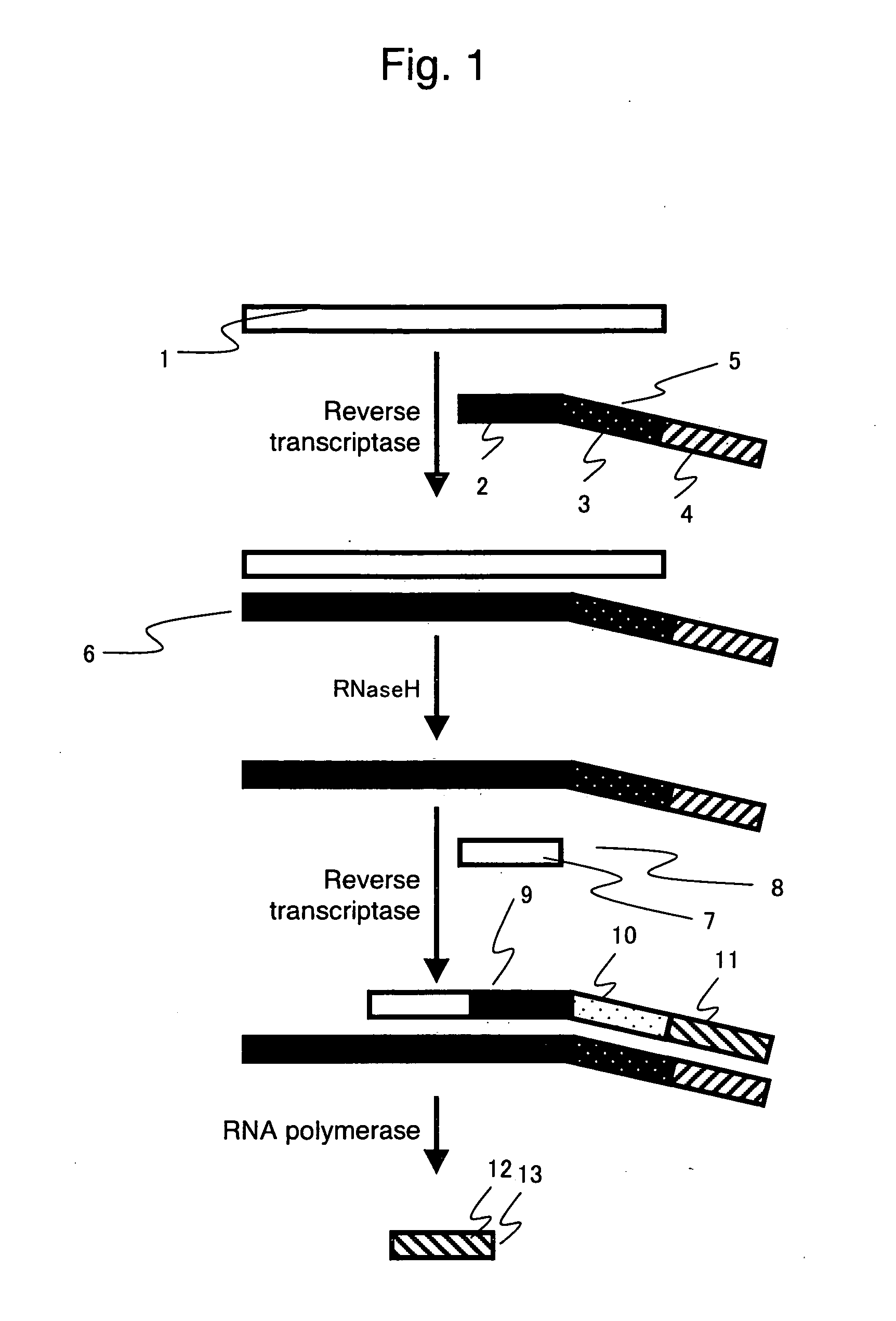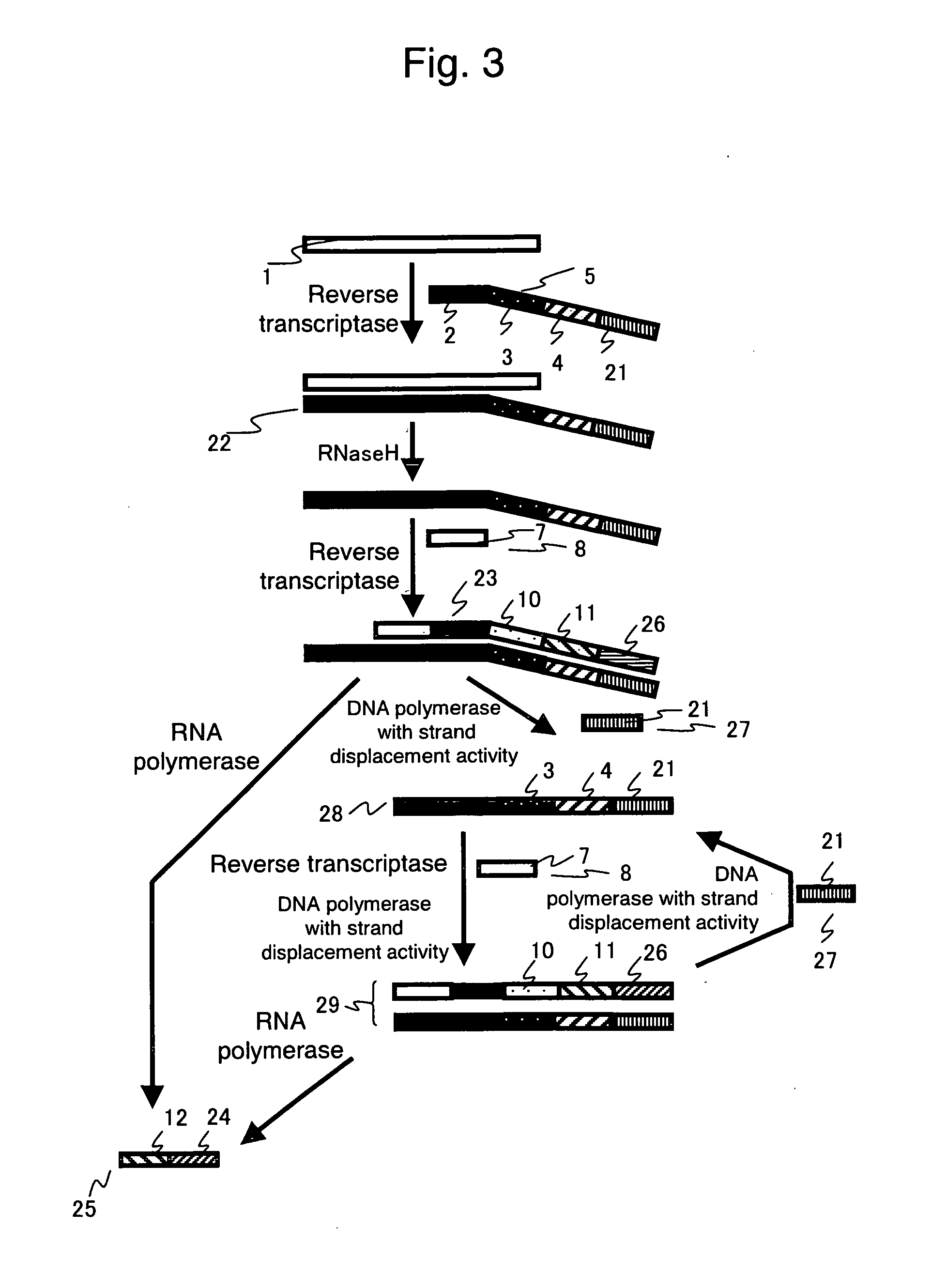Nucleic acid detection method
a detection method and nucleic acid technology, applied in the field of nucleic acid (dna or rna) detection methods, can solve the problems of prolonging annealing a primer to a template may not be satisfactorily carried out, and the time frame required for analysis is extended, etc., to achieve the effect of reducing the time frame required for analysis, and reducing the time fram
- Summary
- Abstract
- Description
- Claims
- Application Information
AI Technical Summary
Benefits of technology
Problems solved by technology
Method used
Image
Examples
example 1
[0047] 1. Oligonucleotide Primers Used in Example 1
P1 primer 1:5′-CCCTTCTCACTGTTCTCTCATTCTCCCTATAGT(SEQ ID NO: 1)GAGTCGTATTAGAATTCTCGCAAGCACCCTATCAGGCAGT-3′P2 primer 2:5′-GCAGAAAGCGTCTAGCCATGGCGT-3′(SEQ ID NO: 2)
[0048] 2. Molecular Beacon Probe Used in Example 1
MBPa:5′-CGACGTCCCTTCTCACTGTTCTCTCATACGTC(SEQ ID NO: 3)G-3′
[0049] The amplified product was detected via molecular beacon probe-based real-time PCR assay in order to determine whether or not the gene expression analysis could be carried out in accordance with the procedure according to the first embodiment of the present invention.
[0050] RNA of hepatitis C virus (HCV) genotype II was used as a template (concentration: 1.8×102 μg / ml), and the primers described in 1 above were used as the oligonucleotide primers for amplification. The P1 primer 1 was a reverse primer consisting of: a sequence between positions 1 and 21 from the 5′ end where MBPa hybridized to the amplified product; a sequence between positions 22 and 49 com...
example 2
[0053] 1. Oligonucleotide Primers Used in Example 2
P1 primer 3:5′-ATTTAGGTGACACTATAGAATACCACTCATCTC(SEQ ID NO: 4)TTCTCCCTGTTTCTCCCTATAGTGAGTCGTATTAGAATTCAAGCACCCTATCAGGCAGTA-3′P2 primer 4:5′-GTCTAGCCATGGCGTTAGTA-3′(SEQ ID NO: 5)
[0054] 2. Molecular Beacon Probe Used in Example 2
MBPb:5′-CGACGTCACTCATCTCTTCTCCCTGTTACGTC(SEQ ID NO: 6)G-3′
[0055] The reaction product was analyzed via electrophoresis in order to determine that the procedure of the second embodiment of the present invention could yield an amplified product of interest.
[0056] RNA of hepatitis C virus (HCV) genotype II was used as a template (concentration: 1.8×102 μg / ml), and the primers described in 1 above were used as the oligonucleotide primers for amplification. The P1 primer 3 was a reverse primer consisting of: a sequence between positions 1 and 23 from the 5′ end, which is a promoter sequence of SP6 RNA polymerase; a sequence between positions 24 and 44 where MBPb hybridized to the amplified product; a sequence ...
example 3
[0059] 1. Oligonucleotide Primers Used in Example 3
P1 primer 5:5′-ATTTAGGTGACACTATAGAATACCTCTGTTCCC(SEQ ID NO: 7)TCATCACTTCTTCTCCCTATAGTGAGTCGTATTAGAATTCAAGCACCCTATCAGGCAGTA-3′P2 primer 4:5′-GTCTAGCCATGGCGTTAGTA-3′(SEQ ID NO: 5)
[0060] 2. Molecular Beacon Probe Used in Example 3
MBPc:5′-CGACGTCTCTGTTCCCTCATCACTTCTACGTC(SEQ ID NO: 8)G-3′
[0061] The amplified product was detected via molecular beacon probe-based real-time PCR assay in order to determine whether or not the gene expression levels could be analyzed using the data obtained in accordance with the procedure of the second embodiment of the present invention.
[0062] RNAs of hepatitis C virus (HCV) genotype II serially diluted in 10-fold increments (concentrations: 1.8×103 μg / ml, 1.8×102 μg / ml, 1.8×101 μg / ml, 1.8×100 μg / ml, and 1.8×10−1 μg / ml) were used as templates, and the primers described in 1 above were used as the oligonucleotide primers for amplification. The P1 primer 5 was a reverse primer consisting of: a sequence b...
PUM
| Property | Measurement | Unit |
|---|---|---|
| concentration | aaaaa | aaaaa |
| concentrations | aaaaa | aaaaa |
| concentrations | aaaaa | aaaaa |
Abstract
Description
Claims
Application Information
 Login to View More
Login to View More - R&D
- Intellectual Property
- Life Sciences
- Materials
- Tech Scout
- Unparalleled Data Quality
- Higher Quality Content
- 60% Fewer Hallucinations
Browse by: Latest US Patents, China's latest patents, Technical Efficacy Thesaurus, Application Domain, Technology Topic, Popular Technical Reports.
© 2025 PatSnap. All rights reserved.Legal|Privacy policy|Modern Slavery Act Transparency Statement|Sitemap|About US| Contact US: help@patsnap.com



